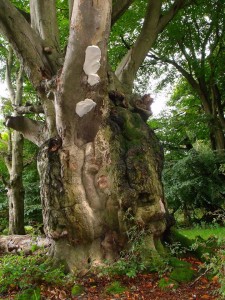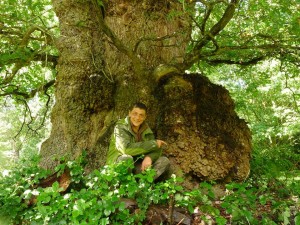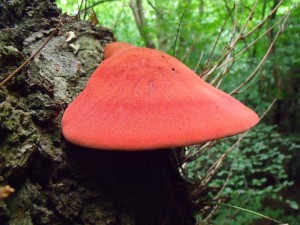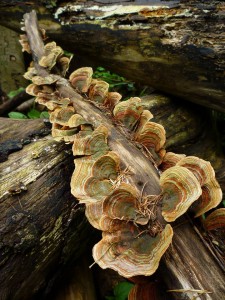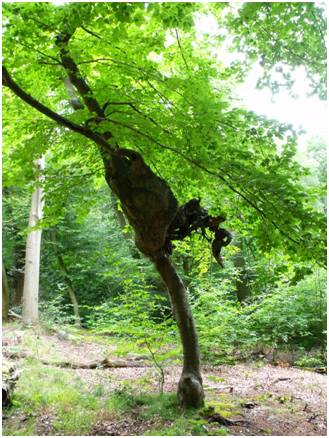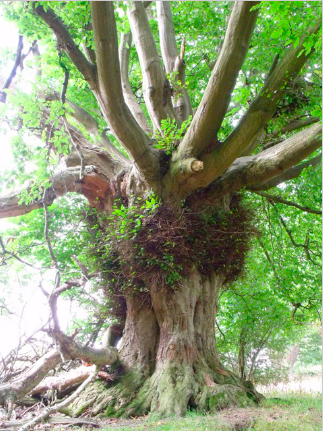by arborist Antony Croft
Ancient Beech with Aurantiporus fissilis
Fungi, what would our woods be like without them? The simple answer is they would not be there! It is remarkable to a mycologist that this concept is not more widely known or appreciated. Trees and Fungi are linked together at the cellular level, it is not possible to separate them into discrete objects with boundaries they are so intimately joined. Dr Alan Rayner said that if we could remove all molecular parts of the tree, sort of vaporise the tree, what we would see is a ghostly relief of the tree, a relief outlined by the single celled Hyphae, the mycelium networks of Fungi, let that sink in for a moment…..It is not that difficult to imagine how complex and vital this relationship is, where would you be without your intestinal gut flora or your white blood cells? Simples…….
It is said that 85-95% of all plants on Earth depend on fungi, but we’re talking mycorrhizal associations, Mycor=Fungus, Rhizo=root. This pays little attention to the fact fungi also break down plant materials and return their carbon and minerals into a usable state for even those plants that do not associate with fungi within the rhizosphere (root-soil interface).
Research is slow to come to light, and mycological research is incredibly difficult and expensive to do, so very little is really known about just how involved the relationship gets. My own field studies (in vivo) which are only anecdotal observations, suggest the relationship is far more complex than we know scientifically or academically. Fortunately I am a humble tree worker and no academic so I can talk about things not proven but observed, and have no fear of ridicule from peer reviews!
Some say it’s not possible for fungi to penetrate and colonise living tissues, well if that’s true, how does pathogenesis occur, and how do mycorrhizae associations occur? It is blindingly obvious…. I hope! Fungi can and do penetrate and colonise living tissue, and what they can do when in there is quiet remarkable.
I believe this large growth (above) is the direct result of one such relationship, I believe that a heart rot fungi called Fistulina hepatica instigates this somehow. Why would fungi want or need to encourage growth this way? Well Fistulina hepatica eats Tannins, the substance produced by oaks in the heartwood regions, and uses the enzyme tanninase to consume them along with Cellulase for breaking down a small percentage of the wood itself. Once the majority of the heartwood has been colonised resources become limited, Does it not makes sense to give the tree a boost and encourage rapid heartwood formation! It even kills off a small area of cambium (Bark) called a necroses or canker to enable it A) to fruit in the open air, or B) to encourage secondary colonisation for a sexual partner! Sound farfetched? Not when you know these clever organisms!
F. hepatica (above). An ancient and mysterious lineage.
Fungi are indeed a fascinating breed, capable of manipulating, benefitting and sometimes compromising whole forests and individual trees in a complex interplay. It is this complexity that makes a mockery of all our attempts to create standardised models for managements, both as Foresters (Silvaculturists) and as Arboriculturists managing single trees in the urban context. In my first article I said Fungi were the true masters of woodland ecology, I hope that is now well and truly self evident!
Both Foresters and Arboriculturists have neglected this side of their professions, slowly but surely I hope to change this and already we see a renewed interest in this fascinating area, long overdue! Of course the critical mass drive required must come from the public, the consumers of our services, so educating the customers is also as vital as educating the industries themselves. Fungi need us all to take due care and consideration for their needs, just as much as we need Fungi and trees for our collective health and well being.
Fearing fungi is a very British pastime, we won’t touch anything other than a “button mushroom” at the local supermarket, and we panic at the site of a mushroom popping out of the lawn, and get the yellow pages out looking for a tree fell’er as soon as a bracket appears on our trees. This is silly in the extreme, very few fungi are toxic to humans, very few have serious implications for tree health and stability, for the most part they are majestic, life supporting organisms that are essential to all life on earth, we need a love resurrection for the Kingdom Mycota!
Stereum subtomentosum, an old growth indicator species, a beautiful wood recycler and harmless!
It’s really not the public’s fault that this fear and loathing exists, it’s further fuelled by an industry that is rapidly capitalising on public fears. Every time somebody dies from a tree failure it receives a massive amount of publicity, people’s fears and emotions take over and lawsuits are filed against humans because trees can’t speak for themselves nor compensate for the loss of a humans life, a family member etc. Trees pay a heavy price for this disproportionate overinflating of the risks from trees, and industry suffers ever tighter regulatory conditions, and the public ever more burdened with the cost of increased risk management strategies.
The reality is trees and fungi exist together in perfect balance for the very, large majority of the time, and with good management, and simple (V.T.A =Visual Tree Assessments- Prof. Claus Mattheck) methodologies big, old, fat and rotten trees can and will continue to coexist with us even in the most urbanised zones. Currently even the professionals take one look at a tree with a bracket, another look at their insurance premiums and decide to exercise very extensive over management, fell the tree on the safe side, the easy lazy option and very poor attitude. I am not suggesting its ALL their fault, it takes two to tango, the public will lynch any arborist/consultant who makes a poor judgment, we are all jointly in some way responsible for this scenario. What i would ask of you all is that the next time your arborist sucks in air through his teeth and goes “Oh dear, thats Honey fungus that love, trees gotta come down” that you ask for –
A) Clarification
B) A second Opinion.
I use that example because it is repeated many thousands of times every year. If I had £1.00 for every client that came to me after being told that very same thing only to find the fungus was in fact a beneficial mycorrhizae I would not need to work anymore! Unfortunately I am not a consultant so I don’t get paid for telling folk the tree is in fact healthy as can be and no work is required, but I do get called back, OFTEN, when work IS warranted. So whether you are an arborist reading this or a customer, hear its message, be a professional, or an educated consumer. Either way stop fearing fungi and learn to see the light out of the darkness of ignorance. Fungi are magnificent, beautiful and more importantly essential to our trees, and consequently to all our health and well beings.
Nurture nature, and enjoy your trees & woodlands.
“The ballerina” a famous beech tree of Burnham beeches.
This tree looks odd because it is now just a remnant of a once much fatter ancient tree. It was pollarded repeatedly for produce when life was simpler. This was a brutal practice, but also enabled trees to live for extended ages because of the reduction of weight. This enabled them to live on despite intense decay.
Another Pollard (left) Ancient Hornbeam from Hatfield Forest
This method of cutting trees (Pollarding) is a brutal practice, it encourages decay, but at the same time reduces the loads imposed by heavy limbs. This decay process is normal, usually, though not always this results in catastrophic failures and often the tree dies as a result. Pollarding however reduces extreme loading on the main stem, the decay is limited to the crown base and heartwoods. When a failure occurs due to decay it usually only means the loss of a limb rather than a whole section of the main stem. This means that very much more often trees that have been pollarded last many centuries longer than their un-managed peers in a community or forest of trees. Mans impact on trees can in this way seem beneficial, we are as much a part of this landscape and eco system as the trees and the fungi…….think on that.
Read more articles by Antony Croft:
Chalara fraxinea- Securing our Shores, Protecting our Forests
Fungi-jewels in the arboreal crown




